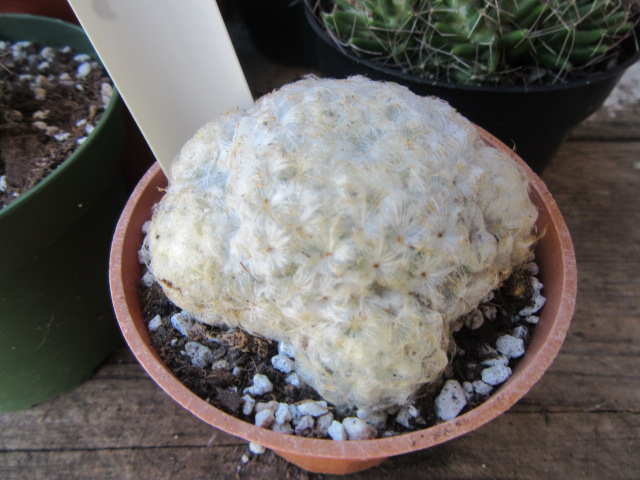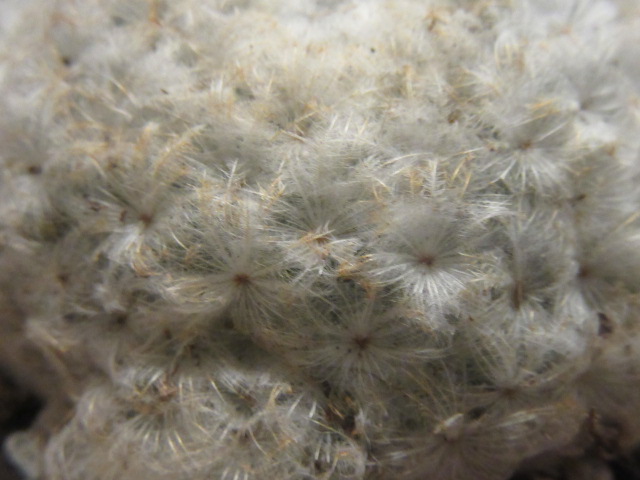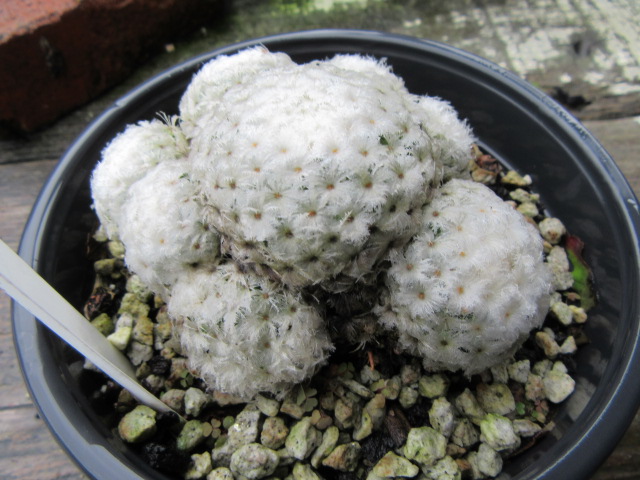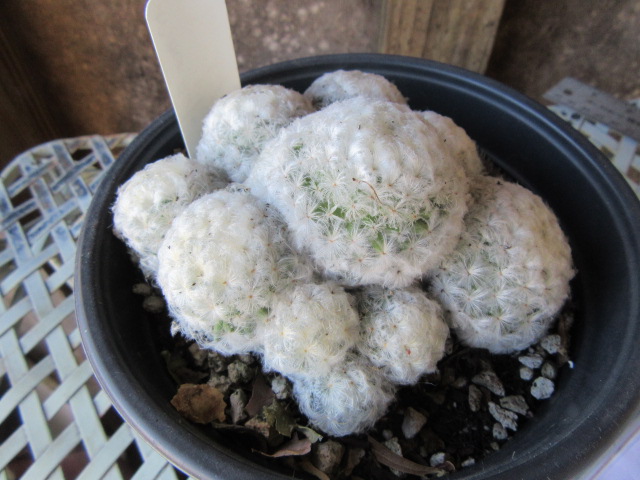
Mammillaria plumosa (Feather Cactus) after I put it in a pot on 9-22-18.
Feather Cactus
Mammillaria plumosa
mam-mil-AR-ee-uh plum-OH-suh
Royal Horticultural Society’s Award of Garden Merit
Synonyms of Mammillaria plumosa (4) (Updated on 12-8-23 from Plants of the World Online): Chilita plumosa (F.A.C.Weber) Orcutt, Ebnerella plumosa (F.A.C.Weber) Buxb., Escobariopsis plumosa (F.A.C.Weber) Doweld, Neomammillaria plumosa (F.A.C.Weber) Britton & Rose
Mammillaria plumosa F.A.C.Weber is the accepted scientific name for this species of cactus. It was named and described by Frédéric Albert Constantin Weber in Dictionnaire d’Horticulture in 1898.
The genus, Mammillaria Haw., was named and described by Adrian Hardy Haworth in Synopsis Plantarum Succulentarum in 1812.
As of 12-8-23 when this page was last updated, Plants of the World Online by Kew lists 138 accepted species in the Mammillaria genus. It is a member of the plant family Cactaceae with 150 genera. Those numbers could change as updates are made on POWO.
THERE ARE SEVERAL LINKS AND GROWING RECOMMENDATIONS AT THE BOTTOM OF THE PAGE FOR FURTHER READING.

Mammillaria plumosa after I unwrapped it from being shipped on 9-22-18, #511-4.
I bought this plant from a seller on Ebay and it arrived on September 22 (2018). It was really NICE and arrived safe and sound wrapped in toilet paper. The selection on Ebay and a few groups on Facebook is much better than what I can find at Walmart and Lowe’s…

Mammillaria plumosa with its roots on 9-22-18, #511-6.
The cluster measured approximately 3/4” tall x 2 1/4” wide. I couldn’t tell how many offsets were in the cluster because of all the fuzz. A single specimen of this species can take a couple of years to offset, but I can feel there are several in this cluster of fuzz. It kind of reminds me of a VERY HAIRY Thimble Cactus (Mammillaria vetula subsp. gracilis).

Mammillaria plumosa on 9-22-18, #511-7.
Mammillaria plumosa is native to Coahuila and Nuevo León in Mexico where it grows on limestone cliffs in sparse shrubland at an elevation of about 2,400 to 4,500 feet (730 to 1,350 meters) above sea level.
Its status in its natural habit is listed as “near threatened” by the IUCN Red List mainly due to illegal collection for trade. Locals also collect and sell the plants at local markets during Christmas because they are used to decorate nativity scenes.

Mammillaria plumosa in its new pot on 9-22-18, #511-10.
I put the cluster in the smallest pot I thought it should be in for its size. Cactus do not need large pots because their root system is not that big. Too much soil under the plant can lead to root rot, which is another reason not to overwater.

Mammillaria plumosa on 11-29-18, #534-23.
November 29 was a nice spring-like day, so I took the cactus to the back porch for a photoshoot. I was working on a post to show the difference between the cactus in my collection.
This cluster of plants has one central plant 1 1/2 to 1 3/4″, depending on where you measure, with six offsets.
Mammillaria plumosa is a clumping species that forms dense mounds about 1 1/2 to 3” tall and up to 15” wide completely covered with feathery spines.

Mammillaria plumosa close-up on 12-1-18, #535-18.
The areoles on its small, flattened tubercles produce about 40 radial spines that are feathery and interlacing. The spines themselves produce hairs along their axis which makes them resemble a bird’s feathers. Mauseth Research says, “Epidermis cells on spines of Mammillaria plumosa grow out as trichomes, shading the plant.” This species has no central spines.
Llifle (Encyclopedia of Living Forms) says, “The spines in this species have very long hairs along the spine-axis arranged as are the segments of a bird’s feather and that furnish an epidermal protection against the blasting sun of the desert.”
I looked at the plant closely with a magnifying glass and it was still fairly difficult to see what was going on because everything is so small. The tubercles are fairly close together so the radial spines kind of interlace with each other. The radial spines, even though Llifle says they are 1-7 mm long, some of them measured 1/8″ long and are pretty stiff. Even though they are thin and stringy looking, they are more like very thin wire. Very few resemble feathers, BUT if you look closely at the above photo you can actually see a few in this photo that do look like feathers… The wooliest areas are around the apex and feel like cotton. Oh yeah… The brown spots in the photo are the centers of the areoles. It is going to be neat watching this plant grow.
By the time I was finished looking the plant over, it was telling me, “ENOUGH ALREADY!”
<<<<2019>>>>

Mammillaria plumosa on 6-22-19, #593-32.
Once evening temperatures warmed up I moved the potted plants back outside for the summer. I moved the cactus to the back porch where they could receive full sun.
I was fairly busy during the summer so I didn’t take many photos. All the plants did very well despite a little neglect.

Mammillaria plumosa at 1 1/2″ tall x 3″ wide on 10-11-19, #639-69.
I had to bring the potted plants inside on October 11 because an “F” was in the forecast. I always take photos of the plants as I bring them inside and measure the cactus and some of the succulents. The Mammillaria plumosa cluster measured approximately 1 1/2″ tall x 3″ wide. It measured 3/4” tall x 2 1/4” wide when I received it on 9-22-18.

Mammillaria plumosa on 10-11-19, #639-70.
I have several neat cacti in my small collection and the Mammillaria plumosa is definitely one of the most interesting.

Mammillaria plumosa flowers on 11-2-19, #646-5.
I was very happy when I saw a few buds poking upon the Mammillaria plumosa and after a while, the flowers started to open. November 2 was a nice spring-like day so I took several cacti outside to get some good photos of their flowers. Llifle says they produce yellowish-white flowers sometimes with pink mid-stripes and have a strong scent. Well, I didn’t think to sniff the flowers to check.

Mammillaria plumosa flower on 11-2-19, #646-6.
To me, the flowers are more of a creamy white, but they do have a very faint pinkish stripe down the middle.
AWESOME!

Mammillaria plumosa repotting on 11-13-19, #649-14.
Several cactus and succulents needed to be re-potted so I started doing that on November 13. Some just needed their soil changed while others needed bigger pots. I used about 50/50 Miracle Grow Potting Soil and pumice for the mix. There are many recipes online for cactus and succulents, but I prefer something simple. I had used a mixture of 2 parts potting soil with 1 part chicken grit and 1 part perlite for many years then read where succulent enthusiasts prefer pumice. SO, I have been trying that since the fall of 2018 with favorable results. I repot any time of the year as necessary, but I have found Fall is a great time. After a summer of regular watering, the potting mixture can become kind of hard when it is decreased. Repotting in the Fall gives the plants nice and loose soil for the winter.
Usually, you shouldn’t increase the pot size that much for cactus because they don’t have a very extensive root system. Too much soil under their roots where moisture isn’t used can cause their roots to rot. I use an old aluminum nail (that mom bought MANY years ago for baked potatoes) to tamp the potting soil between the plant and the side of the pot.

Mammillaria plumosa repotting on 11-13-19, #649-15.
Always make sure to center the plant in the pot and make sure they are standing straight. You wouldn’t want your plants to feel lop-sided. 🙂

Mammillaria plumosa in its new pot on 11-13-19, #649-16.
Sometimes the flowers are open and sometimes they are closed. Old flowers fade and fall off and a few new buds emerge and eventually open.

Mammillaria plumosa on 11-18-19, #653-4.
Many cactus grow very slowly and waiting for their buds to open can get ridiculous. Once you notice a few buds, you look every day to see how big they are. Eventually, you forget about them, and the next thing you know you have flowers. Wait too long and it’s too late. Patience, so it is said, is a virtue.
<<<<2020>>>>

Mammillaria plumosa (Feather Cactus) at 1 3/8″ tall x 3 1/4″ wide on 10-15-20, #747-75.
I had to bring the potted plants inside for the winter on October 15 (2020) because an “F” was in the forecast. As always, I took photographs and measurements. The Mammillaria plumosa did very well over the summer and the tallest in the group was 1 3/8″ tall and the clump was 3 1/4″ wide.

Mammillaria plumosa (Feather Cactus) on 11-6-20, #755-3.
I took a few more photos of this cactus as I was writing the post Fall 2020 Update Part 5: The Mammillaria Group. I had to get a few close-ups of the Mammillaria plumosa flowers.

Mammillaria plumosa (Feather Cactus) on 11-6-20, #755-4.
I think this hole is where an old flower was. 🙂
<<<<2021>>>>

Mammillaria plumosa (Feather Cactus) at 1 3/4″ tall x 4 3/8″ wide on 10-28-21, #853-20.
I didn’t have to move the potted plants inside for the winter until October 28 in 2021. There wasn’t a chance of an “F” in the forecast until then which was quite unusual. The Mammillaria plumosa may look a little strange in the above photo because we had rain and its “plumage” was kind of wet. It did very well over the summer and the largest plant in the cluster grew to 1 3/4″ tall. The entire cluster measured 4 3/8″ wide.
USEFUL INFORMATION:
Family: Cactaceae
Origin: Coahuila, Nuevo León, & Tamaulipas in Mexico.
Zones: USDA Zones 9a-11 (20-40° F)
Size: Around 5” tall x 16” wide clumps
Light: Sun to light shade
Soil: Very well-draining soil. Potting soil amended with pumice (50/50) or additional perlite and chicken grit (2-1-1).
Water: Regular watering during the summer and barely in the winter. Keep water off the spines (feathers) for best appearance… Well, mine is outside during the summer rain or shine… 🙂
You can read my Cactus Talk & Update and Cactus & Succulent Tips to get my opinion about growing cactus and succulents.
When you bring your new plants home from the store, you need to check their roots and the soil to see if they are wet. If so, you may want to re-pot it right away. It is advisable to re-pot them in a better potting soil that is more suitable for cactus and succulents.
<<<<2022>>>>

Mammillaria plumosa (Feather Cactus) at 2″ tall x 4 1/4″ wide on 10-16-22, #919-28.
I had to move the potted plants inside for the winter on October 16 in 2022 (an “F” was in the forecast). I moved the cactus to the front porch with the succulents in the spring and they did very well in a little more shade. It is certainly a good thing this Mammillaria plumosa hasn’t had any problems with mealybugs. How would you tell? I bought this cactus from a seller on Ebay in 2018 and it has been great. In fact, it is the only cactus I bought from Ebay that has survived. Even though it was very small at 3/4″ tall x 2 1/4″ wide it has done very well. The main plant has grown to 2″ tall and the whole cluster is now 4 1/2″ wide. This one you can pet if you so desire…
<<<<2023>>>>

Mammillaria plumosa (Feather Cactus) at 2 1/2″ tall x 4 3/4″ wide on 10-23-23, #967-30.
Even though there was no “F” in the forecast until October 30, it was going to be a rainy week so I moved the potted plants inside on the 23rd and 24th. Time for photos and measurements…
The Mammillaria plumosa did very well during the summer on the back porch in full sun despite the heat and drought. The tallest and biggest ball of feathers measured 2 1/2″” tall and the whole cluster was 4 3/4” wide when I moved it inside for the winter.
I will continue adding more photos and information as time goes by. This plant will definitely be interesting.
I hope you enjoyed this page and maybe found it useful. I would like to hear from you if you have any comments, questions, or suggestions. Please click on “like” if you visited this page. It helps us bloggers stay motivated. 🙂 You can check out the links below for further reading. The links take you directly to the genus and species of this plant. You can also send an email to thebelmontrooster@yahoo.com.